Karate right hand
Time went by. Today, a combat helicopter is much more than just a tank destroyer. It solves the tasks of fire support of ground forces on the battlefield, escorting columns and airborne troops, fighting landings and low-speed air targets of the enemy. Now, without helicopters, a ground combat operation has little chance of success.
Combat helicopters became the basis of the army aviation in many countries. The army, equipped with a rotary-wing attack aircraft, received an absolute advantage over the enemy, deprived of such equipment.
Afghan polygon
In 1961, in the USSR, the first flight was made by a Ka-25PL naval helicopter designed to destroy atomic submarines. In 1969, the military MI-24А rose into the air. Each subsequent modification of it - Mi-24D (1972 g.), Mi-24В (1973 g.), Mi-24П (1975 g.) - exceeded the previous one in efficiency. weapons.
As regards the combat experience of using helicopters, by this time the Americans had a definite advantage. But the Soviet machines were not inferior to the American AN-1G Hugh Cobra (1965) and the AN-IS Cobra-Tow (1974) in any of the key parameters of the performance characteristics.
The Mi-24 helicopter was created for the European theater. However, fate was eager to fight, he began in Afghanistan: in a completely different, new for him, conditions. To more clearly present the difference in the physico-geographical conditions of the Afghan and European theaters, suffice it to say that the average height in Europe is approximately 500 m above sea level, and in Afghanistan more than 2000 m, the average positive air temperature in Europe is 15 — 20 degrees, and in Afghanistan - 30 — 35 degrees. Mi-24 required urgent work to increase engine power during takeoff and landing.
Retractable landing gear reduced the helicopter’s radar visibility. Visibility in the infrared range was reduced by shielding engine exhaust. To protect against MANPADS of the type "Strela" and "Stinger" on the Mi-24 installed a system for shooting off false thermal targets and an infrared radiation generator "Ispanka".
During combat operations, it became clear that HAP C-5 are not effective enough. In this connection, Mi-24 with NAR caliber 80 and 122 mm were tested, their use was mastered in horizontal flight and on a gentle dive, as well as with a tailing-down for hitting targets remote from the line of attack on 3 — 5 km. The armament additionally introduced two gondolas with six 7,62 and 12,7 mm caliber machine guns and a total 8300 ammunition ammunition, as well as gondolas with four 40-mm Flame grenade launchers. The armament was also supplemented with two unified cannon containers of the PK-23-250 with guns GSH-23 caliber 23 mm and 500 ammunition ammunition. Now, the power of the Mi-24 weapons was significantly superior to the American Cobras.
Everything is not on textbooks
In this strange war, combat helicopters had to solve tasks, as a rule, independently. Often, the Mi-24 were forced to conduct reconnaissance in force, open firing points and hit targets identified, clearing the way for ground units of the troops. Su-25 storm troopers, sweeping into the blue heights, and ground troops climbing the mountain slopes could do little to help the "turntables."
At the initial stage of the fighting, the crews of the Mi-24 used the accumulated tactics and maneuvers mastered during numerous exercises. They were based on a covert helicopter exit to a given area at extremely low altitudes, a jump and a sudden attack of targets, followed by departure to a low altitude. During such raids, the enemy suffered significant losses.
The losses of helicopters were insignificant and were often caused not by fire damage, but by the lack of skills for pilots to work in high-mountainous areas, gorges and gorge. But foreign advisers that appeared to the enemy quickly made adjustments to the tactics of dealing with helicopters.
The fact is that in mountainous terrain a flight at an extremely low altitude to a given region can be carried out in most cases along a single route. This is known to both the attacking and the defending side. The route of the group of helicopters runs over a lowland bounded on both sides by mountain slopes. In its course between the slopes of the mountains there are restrictions. It was in these places, on the outskirts of the camps, that dushmans were recommended to organize ambushes. The result was not slow. Helicopter combat losses began to grow exponentially.
The Air Force commander had to urgently raise the altitude of flights en route to 2000 — 2500 m above the terrain. It was also recommended to keep as far away from the slopes of the mountains as possible, where the enemy firing points may be located. However, now the groups of helicopters leaving for the mission were seen from afar by observers, who informed in advance about the impending danger.
At the prompting of advisers of a basing site, the enemy began to choose in view of the best organization of air defense. She wore a circular character and was multi-tiered. The tactics of her actions was reduced to a fairly simple and reliable reception. While the helicopters circled at a high altitude and did not pose a danger to the camp, the air defense system was silent, not unmasking itself, letting the helicopters descend. Then, on command, squall fire was launched from all sides.
Scout the air defense system of a particular object in advance almost never succeeded. Therefore, Mi-24 revealed its firing points by reconnaissance in force. To do this, several pairs of combat helicopters consistently declined and caused fire on themselves. After that, using the entire arsenal of weapons and covering each other, they hurried to escape from the ring of fire (in essence, these were suicide crews). In the meantime, other helicopters from the cover group spotted firing points for a subsequent strike.
However, the Mi-24 was quite tenacious even in such conditions. Some cars returned to the base literally riddled. The distribution of bullets on the side surface of the airframe, which was constantly recorded, testified to the improvement of fire resistance from the enemy. At first, the hits were concentrated mainly in the forward fuselage, crew cabs and in the area of the main gearbox. However, with rare exceptions, this did not disable armored helicopters. Soon the distribution of bullet hits sharply shifted toward the tail end of the airframe. Gradually, zones of concentration of holes began to emerge in areas of the loaded joints of the keel beam with the tail and the last with the fuselage, the instrument equipment compartment and the intermediate gearbox, as well as the tail gearbox and the steering screw.
Instructions from experienced advisers were not in vain. They were well aware that the Achilles heel of a single-rotor helicopter is a loaded tail end of the airframe, tail rotor, not duplicated long transmission shafts and gearboxes.
Cobras and Apaches are no exception. Our combat losses have increased. To protect the rear hemisphere of the Mi-24 and Mi-8 helicopters, the Mil Design Bureau and the Air Force Research Institute tried to place shooters with large-caliber machine guns in the rear part of the fuselage. On the Mi-8, this was possible, and on the Mi-24, due to the constructive difficulties, this idea had to be abandoned.
Mi-24 passed the exam for the successful conduct of hostilities in the most difficult conditions of the war in Afghanistan. I am sure that even the new US military helicopters AN-64A Apache and its modifications AH-64D and AH-64D Longbow are unlikely to surpass the Mi-24 in those conditions. After all, they are not intended and are not capable of detecting on the battlefield individual firing points - disguised infantrymen with small arms or with MANPADS. The infantry, which they support from the air, must fight them. For the Apache pilots who participated in Operation Storm in the Desert, where there was practically no fire resistance, Afghanistan would have seemed like hell.
"Black Shark" shows teeth
In 1982, the company KAMOV made the first flight of a combat shock single-seat helicopter of the new generation: Ka-50 “Black Uq Shark”. He is the successor to the legendary Mi-24 and has absorbed all the best of its predecessor.
The main feature of the "Black Shark" - coaxial scheme. With equal engine power, coaxial-rotor helicopters have a thrust of approximately 20% at hover and speeds up to 80 km / h compared to single-rotors with a tail rotor. It is this speed range most often used for maneuvering near the ground, ambushes and attacks due to barriers and shelters. When performing turns on coaxial Ka-50, no additional engine power is required to rotate the tail rotor. Due to this, the Ka-50 exceeds the helicopters of the traditional scheme during combat maneuvering, especially in mountainous conditions and at high air temperatures.
The best maneuver to quickly change the direction of movement at low altitude in order to take a favorable attacking position or care for the shelter is a flat (pedal) turn. Helicopters coaxial schemes perform it efficiently and safely. With single-screw machines, with a certain combination of rotational speed, wind speed and wind direction, the tail rotor may enter the “vortex ring” mode. For this reason, several accidents of Mi-8 and Mi-24 helicopters occurred. The American AN-64A is not immune from this.
With a maximum take-off mass of 10 800 kg, the Ka-50 has a length of 15,6 m, and an AN-64А - 9525 kg and 17,6 m. A more compact “Black Shark” requires less space for turns. When the readers in the photos see how “Apaches”, hiding behind trees and shelters, demonstrate their maneuverability, it is necessary to bear in mind that Ka-50 does it better.
The tail rotor imposes significant restrictions on the combat maneuver of the AN-64A. At this helicopter, at speeds above 120 — 150 km / h, the conditions for the steering screw and tail boom are limited by sliding or are not allowed at all. Ka-50 is capable of performing a flat turn in the entire range of flight speeds. This allows him in the shortest possible time to take a position advantageous for an attack and win an air duel against an opponent.
No less important quality Ka-50 is its aerodynamic symmetry. The behavior of the Ka-50 when performing spatial figures with reversals left and right is predictable and the same. Cross connections in the control channels are practically absent - one more advantage of the Ka-50 in maneuverable combat.
Of particular note is the low level of vibrations inherent in coaxial helicopters. The Ka-50 has no glider oscillations along the course, similar to those made by the steering screw on a single-rotor helicopter. The low level of vibrations favorably affects the work of radio-electronic equipment and the comfortable conditions for a pilot to perform his functional duties. A simple “Black Shark” piloting technique in combination with a low vibration level reduces aiming errors and dispersion when shooting. Accuracy characteristics of weapons significantly improved. This is confirmed by the results of tests of the Mi-24 and the ship's Ka-29, which have the same sights, cannon and unguided rocket weapons. The accuracy of getting NAR to the Ka-29 was about twice as good. Even more impressive progress was achieved on the Ka-50.
The main means of fighting tanks and infantry fighting vehicles is guided missile weapons. On two mobile launchers, under the wing consoles, the Ka-50 sets up to 12 supersonic ATVM “Vortex” with a launch range of up to 10 km. The aiming complex provides the helicopter with the opportunity to attack ground targets from lines located outside the limits in the effective zones of enemy air defense. No other helicopter is available.
After launch, the missile is aimed at the target automatically by a laser beam. An ATGM hit a tank at ranges up to 8 km with probability 0,9. After starting the pilot there is no need to withstand a certain trajectory of movement, the helicopter can perform a maneuver along the course, altitude and speed of flight. The combat part of the ATGM is unified for hitting ground and air targets moving at speeds up to 800 kilometers per hour. Managed anti-tank weapons have high noise immunity and have no world analogues. As for individual characteristics, and for combat effectiveness, it surpasses the weapons of other machines of similar purpose.
In order not to bore the reader with the transfer of a diverse arsenal of means of defeating the Ka-50, we also note the presence of his Igla-B and P-73 missiles for air combat, as well as the NAR of 80 and 122 mm.
Bare hands do not take
The creators of the Black Shark paid much attention to achieving a high level of combat survivability. Engines and transmissions remain functional for some time after complete loss of oil in the oil tanks. The design is widely used power elements of composite polymeric materials that are resistant to damage by bullets and shrapnel. Provides protection from missiles with heat heads pointing.
The cockpit is fully protected by highly resistant spaced double steel and aluminum armor. It can withstand repeated exposure to small arms bullets and shrapnel
cannon shells caliber 23 mm. A bulletproof flashlight by armor type Mi-24. Main rotor blades - one of the most critical elements of the design - even in the presence of 30 holes from small arms retain sufficient performance to complete the flight. The weight of the cockpit armor protection exceeds 300 kg. For comparison: armored protection of the AH-64A for two pilots is only about 130 kg.
The only non-duplicated Ka-50 unit is the main gearbox, but it is shielded by the design elements of the engine and the wing. There are a lot of non-duplicated aggregates on AN-64А. Among them are the main, intermediate and tail gearboxes, transmission shafts and steering screw. All of them are not shielded from damage. The new-generation American helicopter in terms of vulnerability is no different from the Mi-24.
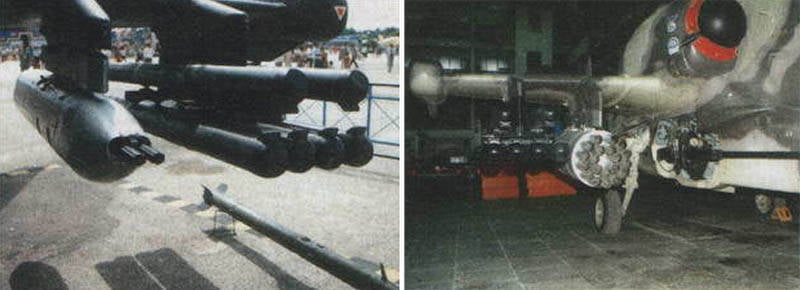
Flies without a tail
Damage or destruction of the rudder and “washers” at the ends of the Ka-50 stabilizer does not lead to a catastrophic situation. In order to maintain track controllability in this case, it is sufficient to reduce the flight speed to 200 km / h or less, and then controllability is provided by changing the reactive torques on the upper and lower rotors. This was confirmed in test flight with a fully removed vertical tail.
Saving the pilot's life in emergency and catastrophic situations is guaranteed by an emergency escape system (SAP). When the SAP is triggered, the blades of the rotor blades are first shot off, then the upper cabin doors open and the jet engines, pulling the seat with the pilot off, with the help of nylon halyards, are triggered. The rescue of the pilot is provided in a controlled and uncontrolled flight in the entire range of speeds and altitudes, including from ground level.
On the Apache, rescue of pilots in an emergency is possible only in a controlled flight, which ends with a rough landing. To effectively depreciate the landing gear and seats, the landing of the machine must be carried out on three points with a roll no more than ± 5 degrees. Already at 10 degrees, depreciation practically does not work. Statistics of the emergency landing of helicopters shows that the landing takes place with angles up to 20 degrees. And how to escape the pilots, if the helicopter will be uncontrollable? What if the flight failed to extinguish the fire? There are no positive responses to AH-64A.
Here you have the “breathtaking” combat survivability of the Apaches, about which foreign authors only superlatively speak.
Day and night
KAMOV Company continues to improve the helicopter attack aircraft. In 1997, the black shark night version appeared. Survey-search system (OPS) of the passive-active type provides it with the ability to use all means of destruction day and night. Day and night Ka-50 will be used together, depending on the specific combat situation.
The success of the ground support operation depends to a large extent on the coherence of the attack helicopters in the group. The team leader’s helicopter should have a richer airborne complex, providing better visibility of the battlefield and communication with the command post. They became the Ka-52 "Alligator" (1997 g.) - a multi-purpose double helicopter. OPS passive-active type allows you to search and attack targets day and night in any weather. Ka-52 is not intended to replace Ka-50. They must act together, thereby achieving the best combat effect.
“Unfortunately, even aces pilots sometimes make mistakes.” At one time, experienced Mi-24 and Ka-50 piloted by test pilots crashed during the performance of demonstration flights. The Kamov Design Bureau together with TsAGI, LII and Air Force institutes have since made certain changes in the design and instructions for piloting the Ka-50. The disaster that occurred 13 years ago, did not affect the fate of the new generation of combat helicopters.
Question: How "tied" Ka-50 to the rear repair bases, how complicated and capricious it is in service?
- Ka-50 with its rich onboard electronic complex and a variety of weapons requires, of course, for the maintenance of various specialists. However, he can carry out combat missions with a given intensity for 12 days in isolation from the main base. At the same time, the necessary types of pre-flight preparations are capable of carrying out a pilot using onboard integrated monitoring systems. As regards the maintainability of the Ka-50, which was created in accordance with the general technical requirements of the Air Force of the new decade, higher demands were placed than on its predecessor Mi-24. 35 percent parts, panels and plating are made of composite polymeric materials. The tail feathers, the airframe lining and the rotor blades are subject to repair in field conditions. In field conditions, for example, all failed equipment blocks, propeller blades, power plant units, and control systems are to be replaced.
Question: How fast can a helicopter be prepared for re-flight?
- “Black Shark” for re-departure requires an external inspection for the absence of combat damage and viewing the metallized tape of the built-in control system “Screen” for the absence of registered failures of systems and equipment. If everything is in order, it remains only to fill the helicopter with fuel and equip it with weapons of destruction. Preparation of the Ka-50 for re-departure in the main version of weapons with an ATGM, cannon and NAR is 20 minutes.
Question: For what main combat missions was the Ka-50 created?
- Attack combat helicopter Ka-50 is designed to destroy modern armored and mechanized vehicles, combat air targets and defeat manpower on the battlefield.
Question: Is it assumed that they will be part of army aviation, or do they have independent combat tasks within separate units (for example, for special purposes)?
- Ka-50 and Ka-52 are intended to be part of army aviation, which is an integral part of the ground forces. Combat helicopters operate over a battlefield in the interests of subunits and units of ground forces. In accordance with the AA charter, they can also perform a number of specific tasks on their own.
In the first variant, the interaction between the combat helicopters and other participants in the operation will be better organized. However, the isolation of the Ka-50 and Ka-52 pilots from AA will affect their professional level. There will certainly be a problem with the promotion of pilots. It is possible that a separate unit is created within the AA, which, in addition to general training, is also undergoing special training.
Question: Were the options for using helicopters in conjunction with parts of Special Forces?
- Ka-50 and Ka-52 have no contraindications for conducting combat operations with special forces. The effectiveness of their application depends on the perfection of the organization of the planned operation and the skillful guidance of their actions in flight.
Question: But, as you said, the Mi-24 was less convenient for special forces than the old Mi-8, since the delivery of the troops on it was extremely difficult?
- Indeed, the Mi-24 proved to be less effective than the Mi-8МТ, for the landing of the assault. In addition, a cargo cabin weighing about a ton has significantly impaired its maneuverability and take-off and landing characteristics. The research and experience in the hostilities in Afghanistan led to the understanding that AA should have both purely combat strikes and armed helicopters for the assault landing and evacuation of the wounded from the battlefield, closely interacting with each other. In the interests of AA, KAMOV is building a low-profile Ka-60 high-speed helicopter with a take-off weight of 6500 kg, designed for 14 transport, fully equipped paratroopers or 6 injured on stretchers with three accompanying medical personnel. The function of evacuating the wounded or delivering a landing force by the military Ka-50 and Ka-52 in the TTZ was not specified.
Question: The Chechen war showed the need to use helicopters at low altitudes, but in this case they are subjected to intense fire by all means of air defense, even grenade launchers and machine guns. How much is this taken into account in Ka-50?
- Ka-50 is equipped with a pilot warning system about the exposure of the device to enemy enemy laser and radar stations to take timely masking measures by going to extremely small heights (10 — 25 m) using the screening effect of the terrain.
To reduce the infrared visibility at the exit of the engines, screen-mounted exhaust devices are installed, and a system for shooting off false heat targets is available for jamming missiles with thermal homing heads.
The retractable landing gear contributes to a decrease in radar visibility, and camouflage coloring to match the color of the terrain with a low reflective effect contributes to the optical one. Depending on the terrain, altitude, and specifically the current combat situation, the pilot can use the entire range of horizontal flight speeds from 0 to 310 km / h, and taking into account the possibility of diving - to 390 km / h.
As for small arms, the Ka-50 has powerful circular cockpit armor, a resistant to destruction structure of power elements, shielding vital aggregates with less important, effective fire extinguishing system and preventing fuel explosion in tanks.
Question: How picky Ka-50 to the quality of the platform for takeoff and landing?
- The high efficiency of coaxial rotors and the lack of power loss to the drive of the missing tail rotor ensured the Ka-50, the largest static ceiling among existing helicopters: 4000 m. In high-altitude conditions, it can successfully land and take-off from platforms located at altitudes up to 4000 m, using the hang outside the influence of the screen surface of the earth (15 m and more).
With the height of the 3 — 5 hang-up m using the surface screen, take-off and landing can also be carried out at high altitudes, including those with a greater take-off weight.
The wheeled chassis is designed to operate the machine on the ground or with a 6 kg / sq. cm - that is, on the trampled earthen areas. For operation on areas with a softer ground apply additional installed skis. From the point of view of the nature of the surface of the site, the Ka-50 is less whimsical in comparison with the helicopters of the traditional scheme due to the absence of the tail rotor, which can be damaged by stones, pebbles, pieces of ice, raised by the air flow from the rotor. The magnitude of the slopes of the sites, it does not differ from the Mi-24.
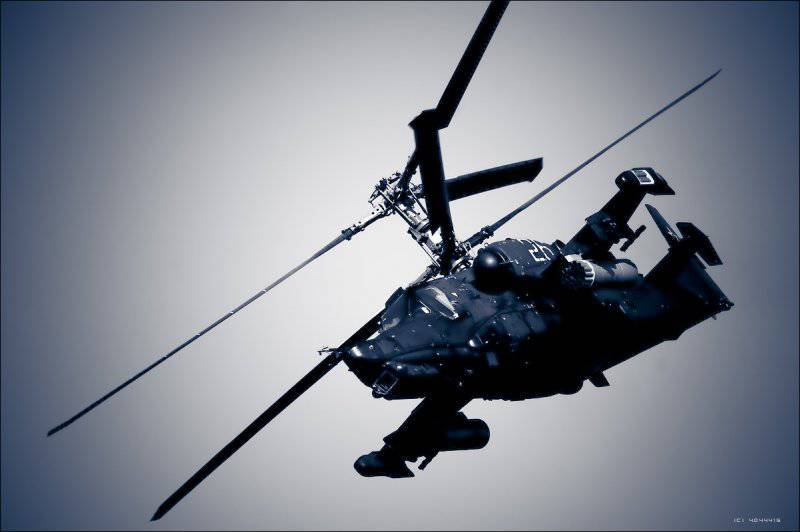
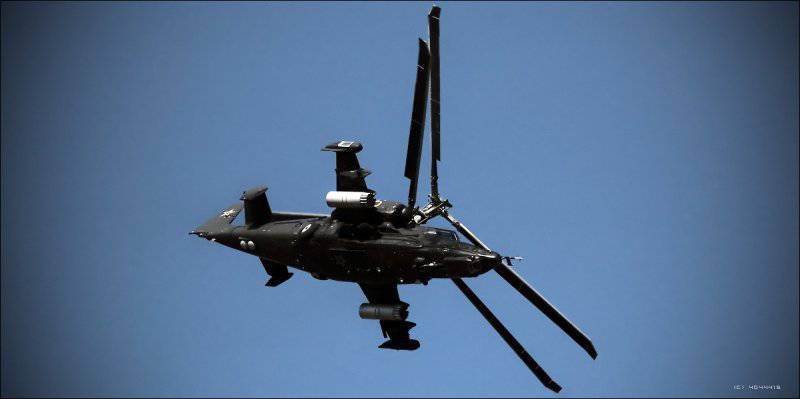

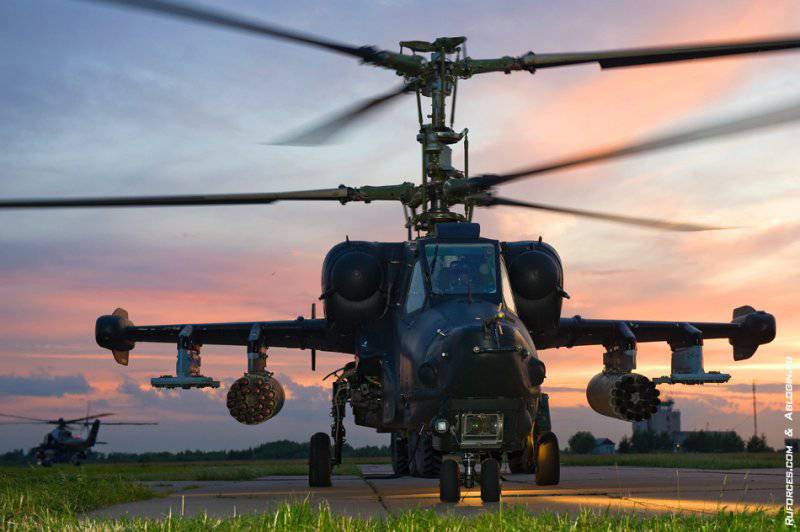
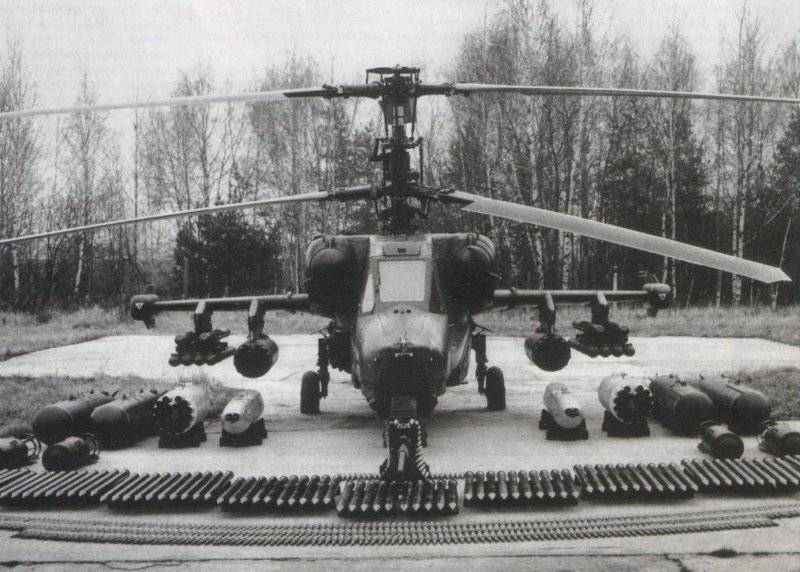
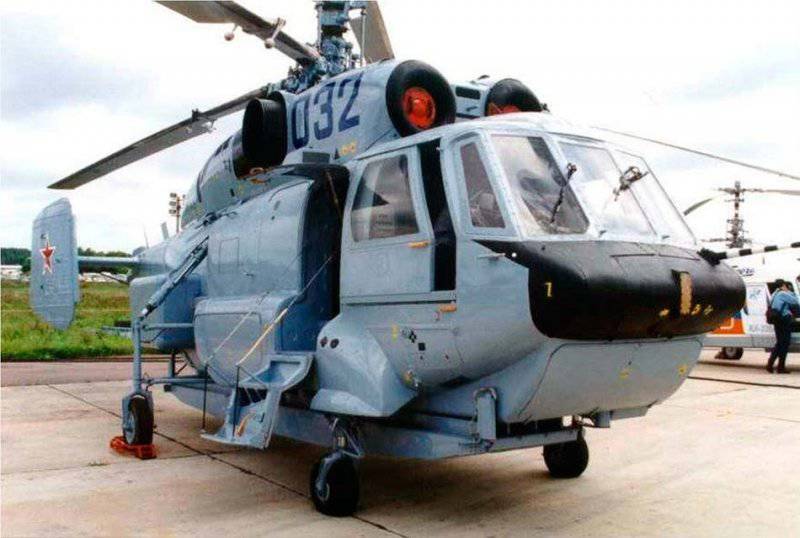
Information